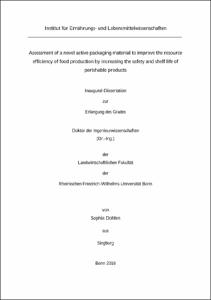Assessment of a novel active packaging material to improve the resource efficiency of food production by increasing the safety and shelf life of perishable products
Assessment of a novel active packaging material to improve the resource efficiency of food production by increasing the safety and shelf life of perishable products
| dc.contributor.advisor | Kreyenschmidt, Judith | |
| dc.contributor.author | Dohlen, Sophia | |
| dc.date.accessioned | 2020-04-21T15:03:30Z | |
| dc.date.available | 2020-04-21T15:03:30Z | |
| dc.date.issued | 22.12.2016 | |
| dc.identifier.uri | https://hdl.handle.net/20.500.11811/6639 | |
| dc.description.abstract | The objective of this thesis was the assessment of novel active packaging materials containing the polymer poly-[2-(tert-butylamino) methylstyrene] (poly(TBAMS)) for the application in perishable food supply chains. Furthermore, the potential of active packaging materials to increase the safety and shelf life of perishable products and thus to improve the resource efficiency of food production was assessed. The influence of food components, environmental factors, and different processing steps was analysed on the antimicrobial activity of 24 different processed materials containing poly(TBAMS). In total 714 samples containing poly(TBAMS) and 1032 references were investigated. Based on the results, certain kinds of packaging prototypes were produced for storage tests. 883 samples were tested in 15 storage trials with perishable product to assess the effect of poly(TBAMS) on product specific microbial, sensory, quality and chemical parameters. The modelling of the growth of spoilage and pathogenic bacteria, yeasts and moulds and the shelf life determination were conducted by using the modified Gompertz function. Based on all results, a standardized evaluation scheme for the assessment of active packaging materials` ability to increase the safety and shelf life of perishable foods were developed. Further an approach to analyse the cost and benefits by implementation of active packagings were developed. Calculations were exemplified for poly(TBAMS) packagings. Different materials containing poly(TBAMS) showed a high antimicrobial activity against spoilage and pathogenic organisms relevant for perishable products. The food components (especially proteins), temperature, gas atmosphere and the processing of the polymer itself influenced the activity. The activity depended on the availability of functional groups of poly(TBAMS) on the polymeric surface, which increased by increasing the concentration or enlarging the surface. A multilayer foil containing 15 % of poly(TBAMS) in the inner layer increased the microbial safety and shelf life of products with low protein contents, such as R-T-E vegetables, and of processed meat products. Thus, the novel packaging solutions have high potential to reduce food waste by increasing the safety and shelf life of perishable foods. The developed evaluation scheme allows the identification of the application area where an active material delivers the highest benefit during the development phase. The cost–benefit analysis represents a new approach for the calculation of the economic and resource-efficient impact by implementation of different active packaging materials. Both can lead to a reduction of time and costs during developing of antimicrobial packaging materials. | en |
| dc.description.abstract | Bewertung eines neuartigen aktiven Verpackungsmaterials zur Steigerung der Ressourceneffizienz der Lebensmittelproduktion durch eine Erhöhung der Sicherheit und Haltbarkeit leichtverderblicher Produkte Ziel der Arbeit war die Bewertung neuartiger aktiver Verpackungsmaterialien auf Basis von poly-[2-(tert-butylamino) methylstyrene] (poly(TBAMS)) hinsichtlich der Anwendung in Wertschöpfungskette für leichtverderbliche Lebensmittel. Weiterhin wurde im Rahmen der Arbeit eine standardisierte Vorgehensweise entwickelt, um das Potential von aktiven Verpackungen zur Erhöhung der Sicherheit und Haltbarkeit leicht verderblicher Produkte sowie deren Beitrag zur Verbesserung der Ressourceneffizienz zu bewerten. Für die Bewertung des neuen Polymers wurde der Einfluss von Lebensmittelinhaltsstoffen, Umweltfaktoren und verschiedener Verfahrenstechniken bei der Herstellung der Verpackungsmaterialien auf die antimikrobielle Aktivität analysiert. Insgesamt wurden 714 poly(TBAMS) enthaltende Materialproben und 1032 Referenzen untersucht. Basierend auf den Ergebnissen erfolgte die Herstellung verschiedener Folien und Vliese für die Lagerungstests. 883 Proben wurden in 15 Zeitreihen mit leicht verderblichen Lebensmitteln getestet, um den Effekt von poly(TBAMS) auf produktspezifische Parameter zu bewerten. Die Modellierung des Wachstums verschiedener Bakterien, Hefen und Pilze, und die Ermittl-ung der Haltbarkeitszeiten erfolgte mit der modifizierten Gompertzfunktion. Auf Grundlage aller Analysen wurde ein Prüfschema zur Bewertung aktiver Materialien im Hinblick auf ihre Eignung, die Haltbarkeit leicht verderblicher Lebensmittel zu erhöhen, entwickelt. Zudem wurde eine Vorgehensweise entwickelt, um die Kosten und Nutzen von aktiven Verpackungen für die unterschiedlichen Stufen der Wertschöpfungskette zu berechnen. Verschiedene poly(TBAMS) enthaltende Materialen zeigten eine hohe antimikrobielle Aktivität gegen eine Vielzahl Verderbnis erregende und pathogene Bakterien. Einige Lebensmittelinhaltstoffe (insbesondere Proteine), die Temperaturbedingungen und die Compoundierung des Polymers mit verschiedenen Matrixpolymeren beeinflussten die Wirksamkeit. Die Aktivität des Polymers konnte mit der Erhöhung der Konzentration von poly(TBAMS) oder durch eine größere Polymeroberfläche gesteigert werden. So zeigte eine Mehrschichtfolie mit 15 % poly(TBAMS) in der Innenschicht eine Haltbarkeitsverlängerung bei Fleischprodukten und bei proteinarmen Lebensmitteln, wie zum Verzehr fertiges Gemüse. Das entwickelte Prüfschema sowie die Kosten-Nutzen Analyse ermöglichen es, geeignete Anwendungsgebiete antimikrobieller Polymere schon während der Entwicklungsphase zu identifizieren. Dadurch können die Entwicklungszeiten und -kosten deutlich reduziert werden und durch verlängerte Haltbarkeitszeiten wichtige Ressourcen geschont werden. | en |
| dc.language.iso | eng | |
| dc.rights | In Copyright | |
| dc.rights.uri | http://rightsstatements.org/vocab/InC/1.0/ | |
| dc.subject.ddc | 620 Ingenieurwissenschaften und Maschinenbau | |
| dc.title | Assessment of a novel active packaging material to improve the resource efficiency of food production by increasing the safety and shelf life of perishable products | |
| dc.type | Dissertation oder Habilitation | |
| dc.publisher.name | Universitäts- und Landesbibliothek Bonn | |
| dc.publisher.location | Bonn | |
| dc.rights.accessRights | closedAccess | |
| dc.identifier.urn | https://nbn-resolving.org/urn:nbn:de:hbz:5n-45896 | |
| ulbbn.pubtype | Erstveröffentlichung | |
| ulbbnediss.affiliation.name | Rheinische Friedrich-Wilhelms-Universität Bonn | |
| ulbbnediss.affiliation.location | Bonn | |
| ulbbnediss.thesis.level | Dissertation | |
| ulbbnediss.dissID | 4589 | |
| ulbbnediss.date.accepted | 20.12.2016 | |
| ulbbnediss.fakultaet | Landwirtschaftliche Fakultät | |
| dc.contributor.coReferee | Pude, Ralf |
Dateien zu dieser Ressource

Dieses Dokument ist zur Zeit gesperrt.
Das Dokument erscheint in:
-
E-Dissertationen (1115)



